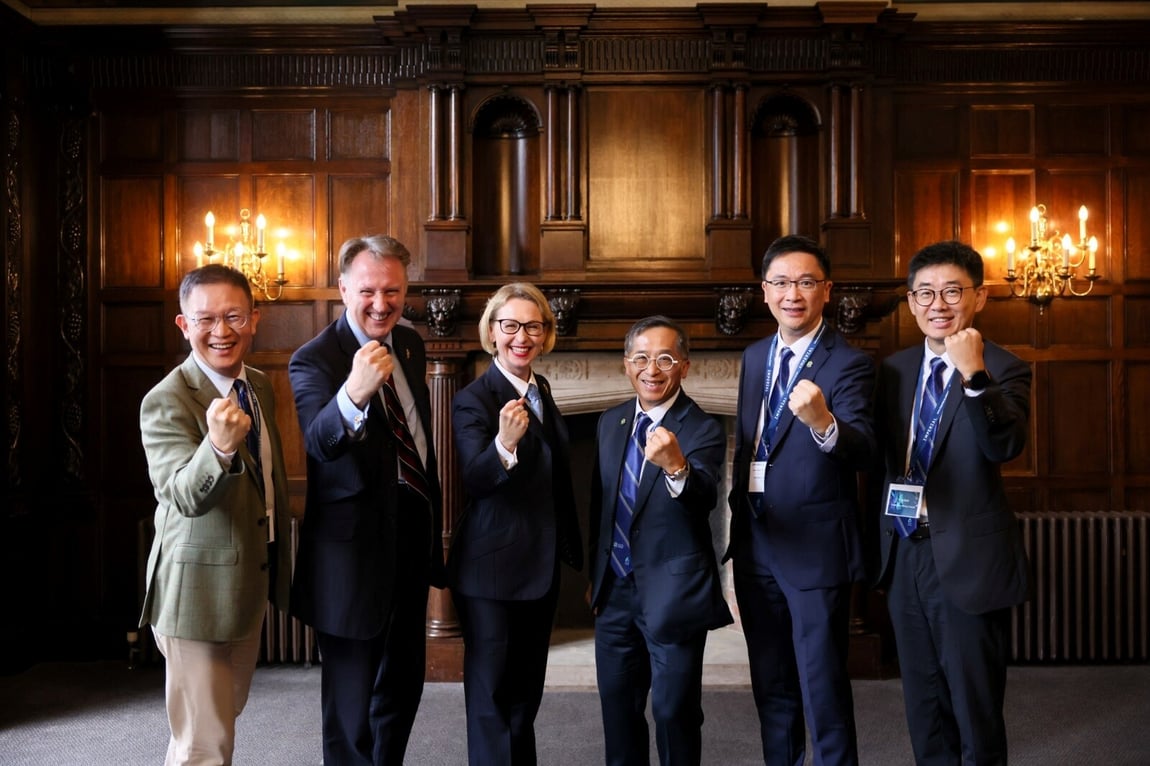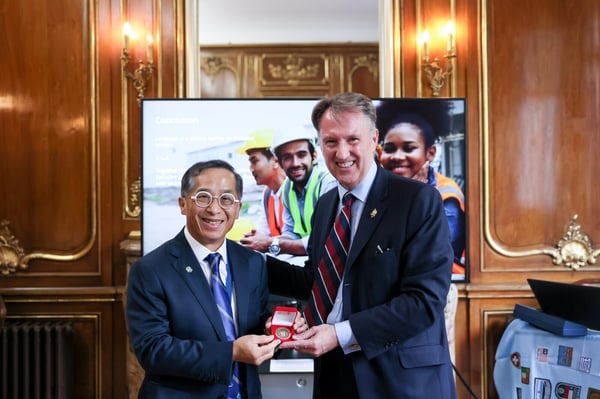
The future of inclusive safety training is multilingual
The Hong Kong Construction Industry Council (CIC) Future Construction Excellence (FCE) Programme took place at Imperial College, London last month with a mission to embrace innovation and technology and achieve high quality productivity.
The delegation of future leaders, led by Ir Prof. Thomas HO, Ir Albert Cheng, Alex Ho and Dr Morgan Yang, were welcomed by Prof. Washington Ochieng CBE, Head of the Department of Civil and Environmental Engineering and Mr Mark Enzer OBE, former Head of the UK National Digital Twin programme and strategic advisor at Mott MacDonald.
On the first day, Guildhawk was honoured to address the leaders on new techniques for leading regenerative and inclusive growth.
Protecting life on worksites
The session explored how translation technologies can be used to better protect life and improve inclusivity especially among migrant workers with limited language skills.
- David Clarke, Director at Guildhawk, began the hour-long deep dive, with a concerning statistic that: “Every year, 1.9m workers die across the globe due to work-related causes. Yet, many incidents could be avoided by using data and machine learning technology to make safety training available to workers in their language”.
Every few minutes, the tranquillity in the mahogany ballroom at Prince’s Gate was interrupted by the sombre sound of a single bell chime – a chilling reminder of the ever-growing death toll in industries across the globe.
Ask, listen and act
“Talking about protecting people is easy, but turning words into action is hard”, David said. He explained how three words, Ask, Listen and Act, were his mantra for identifying problems and implementing solutions when addressing major challenges as a police leader and post-war investigator with the United Nations.
- Before considering how to solve future threats he advocated looking to the past to discover what worked, what didn’t, and why.
To illustrate this, the leaders were taken on a journey back in time to the terrorist bomb attacks in central London in the 1990’s. News footage taken by David and his emergency services colleagues on the night of the St Mary Axe bomb on 10th April 1992, portrayed the eerie scene of a newly constructed building that had collapsed, shattering glass in nearby tower blocks, and leaving a large crater in the road.
BBC news footage from a second huge bomb a year later at nearby Bishopsgate further illustrated the horrific force of the explosions which put the public and police in mortal danger.
Improving safety with innovation
Following the terrifying incidents, leaders across sectors quickly united, asked questions, listened, and acted. “The result was the collective development of new, world-class technologies to safeguard people, property and the economy”, David explained.
- The horror that hurt so many people, and caused a billion pounds of damage, became a catalyst for unity and unprecedented global collaboration to improve safety through better engineering, education, and enforcement.
Structural design enhancements saw new buildings designed with reinforced concrete and steel frameworks to better absorb and dissipate blast energy. This included the use of shear walls and moment-resisting frames to improve overall structural integrity.
The development of blast-resistant façades became a priority. These façades were designed to withstand high-pressure waves from explosions, minimising damage and protecting occupants. Techniques such as increasing the ductility of materials and incorporating energy-absorbing elements were employed.
Evidence showed most injuries were caused by shards of plate glass propelled at speed, so windows and glass doors were upgraded with laminated glass and polycarbonate layers to prevent shattering upon impact. This glazing technology helped to reduce the risk of injury from flying glass shards during an explosion or a natural disaster.
New technologies to eliminate avoidable deaths
As the bell continued to sound, a digital human avatar of Jurga Zilinskiene MBE, Founder of Guildhawk and Evernoon 尚日 appeared on screen and spoke. She told construction leaders in fluent Cantonese how her mission was to eliminate avoidable deaths on construction sites using new AI-powered technologies like avatars.
![]()
When the real Jurga then spoke, she surprised delegates by revealing she does not speak Chinese. She explained how new AI-powered tools like safety videos with multilingual digital humans and GAI Translate™ instantly improve safety.
- These tools work because they enable safety officers to communicate important information to workers in the language they understand best.
Making language a bridge not a barrier to safety education
Giving workers information in their own language inspires positive action and reduces risks. In February 2024, Stefania Giannini, Assistant Director-General, UNESCO wrote:
- ‘Students learn best in a language they understand. Multilingual communication is key to inspiring positive action across the world, ensuring that every community understands the risks and can unite in the global effort.’
Jurga illustrated this by giving instructions in Russian to two colleagues.
No one in the room, other than Jurga, could understand what was being said. She translated the message. It was a warning for everyone to don their personal protective clothing immediately because a wall was about to collapse!
It is easy to see how safety messages can be lost in translation when no one is available to interpret.
Why language is vital for site safety
Language plays a vital role in keeping workers safe on sites around the world, because migrant workers who may not speak the local language can struggle to understand information. This was identified in the research published by Dr Morwenna Fellows.
She found that multilingual sites often encounter specific challenges regarding safety, integration, and productivity. Of particular importance is the fact that workers from a non-English-speaking background are at a higher risk of accidents than their local counterparts.
Hong Kong pioneers of safe working sites
David and Jurga complimented the delegates for being part of a remarkably innovative culture. Hong Kong is a pioneer in the development of smart technologies, exemplified by initiatives such as the Smart Site Safety System (4S) and Walk the Talk, championed by Ir Thomas HO, Chairman of the Construction Industry Council.
Safety is a big priority for Hong Kong and the Greater Bay Area (GBA), because this region has some of the most ambitious infrastructure projects in the world. Plus, leaders care about their workers. They want to ensure that migrant workers are safe and feel included.
Creating regenerative growth that is inclusive and does not exclude older workers is a priority since evidence shows that workers over 60 are at greater risk of fatal injuries.
- For example, 19 site workers died in Hong Kong in 2023; 11 of these were aged 61+ years.
How to make sites safer with language solutions
Hong Kong’s focus on safety and technology has made it an ideal location for Guildhawk to deploy its technologies. Jurga told how Guildhawk is honoured to be the CIC’s partner and is working with a major Tier 1 construction company to develop a machine learning model to improve safety.
Other ground-breaking partnerships are underway using Guildhawk’s latest AI and new techniques to label multilingual datasets. These include Sandvik Canada and Hawcroft Consulting where the GAI Translate™ software and training videos with digital human avatars are being used to improve safety messages.
 Ir Thomas Ho Chairman of CIC is presented with a City of London Police commemorative coin by David Clarke
Ir Thomas Ho Chairman of CIC is presented with a City of London Police commemorative coin by David Clarke
Three actions that organisations can implement today
Research backed by the United Nations, Lloyds Register Foundation and others have called on leaders to urgently do more to protect workers from dangers that are increasing with climate change.
During the session, three new initiatives were presented as solutions that can be applied today to improve how we communicate environmental and safety information to workers to inspire positive action.
Initiative 1: Understand the link between safety risks and language?
Dr Fellows’ research found that migrant workers are often involved in ad-hoc interpreting onsite to help their peers understand briefings and safety information.
The first initiative is a piece of research by Dr Fellows to determine whether there is a direct correlation between health and safety issues and language barriers on construction sites. Leaders in the construction industry were invited to support this work.
Initiative 2: Make all information accessible to workers in their language
The second proposal is to make safety onboarding training and site briefings available to workers in their language.
This initiative can be accomplished quickly using the powerful GAI Translate™ engine. Industry leaders were encouraged to use the product free of charge for a month to experience how it will save them time and improve communication with workers.
Initiative 3: 100 songs for safety
The third initiative was introduced with a short video about the 2012 Australian public safety campaign ‘Dumb Ways to Die’ made by Metro Trains, which became one of the most successful safety campaigns in history.
Deaths on the railways or any other place for that matter are not incidents that organisations tend to sing about. But that’s precisely what the authorities did with a quirky and catchy song that reduced casualties by making safety messages more memorable for people.
Guildhawk is leading a collaboration of experts in music, safety, and AI to create a series of short safety songs generated using a new process that blends Generative AI with human linguistics for the first time.
Leaders that would like to participate in this new creative safety initiative were invited to contact our team to learn more and listen to the first songs.
Conclusion: Making language and AI a bridge to a brighter future
The session concluded with the message that language is a serious barrier not only to safety but to inspiring people across the world.
By asking the right questions, listening, learning from what works, and communicating in the language people understand, organisations can make regenerative, inclusive growth a reality, not a dream.



